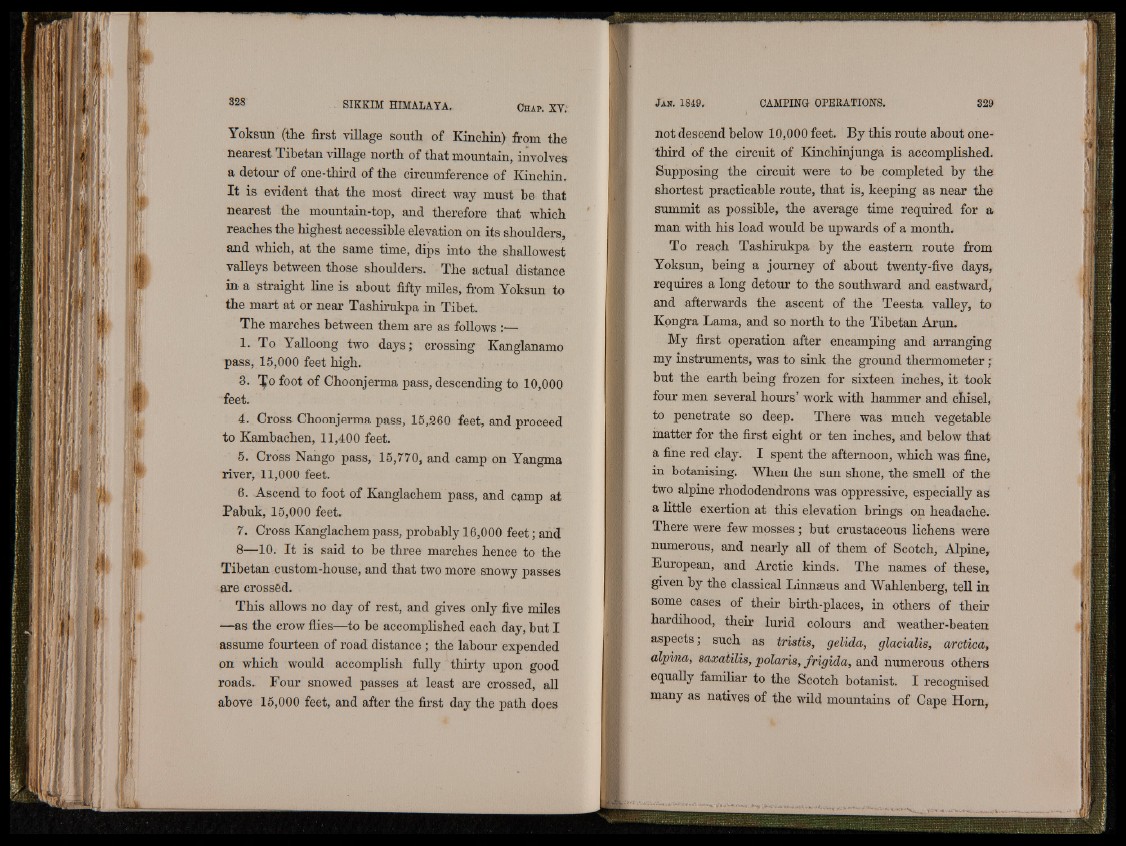
Yoksun (the first village south of Kinchin) from the
nearest Tibetan village north of that mountain, involves
a detour of one-third of the circumference of Kinchin.
I t is evident that the most direct way must be that
nearest the mountain-top, and therefore that which
reaches the highest accessible elevation on its shoulders,
and which, at the same time, dips into the shallowest
valleys between those shoulders. The actual distance
in a straight line is about fifty miles, from Yoksun to
the mart at or near Tashirukpa in Tibet.
The marches between them are as follows :—
1. To Yalloong two days; crossing Kanglanamo
pass, 15,000 feet high.
3. ^o foot of Choonjerma pass, descending to 10,000
feet.
4. Cross Choonjerma pass, 15,260 feet, and proceed
to Kambachen, 11,400 feet.
5. Cross Nango pass, 15,770, and camp on Yangma
river, 11,000 feet.
6. Ascend to foot of Kanglachem pass, and camp at
Pabuk, 15,000 feet.
7. Cross Kanglachem pass, probably 16,000 feet; and
8—10. I t is said to be three marches hence to the
Tibetan custom-house, and that two more snowy passes
are crossed.
This allows no day of rest, and gives only five miles
—as the crow flies—to be accomplished each day, but I
assume fourteen of road distance; the labour expended
on which would accomplish fully thirty upon good
roads. Four snowed passes at least are crossed, all
above 15,000 feet, and after the first day the path does
not descend below 10,000 feet. By this route about one-
third of the circuit of Kinchinjunga is accomplished.
Supposing the circuit were to be completed by the
shortest practicable route, that is, keeping as near the
summit as possible, the average time required for a
man with his load would be upwards of a month.
To reach Tashirukpa by the eastern route from
Yoksun, being a journey of about twenty-five days,
requires a long detour to the southward and eastward,
and afterwards the ascent of the Teesta valley, to
Kongra Lama, and so north to the Tibetan Arun.
My first operation after encamping and arranging
my instruments, was to sink the ground thermometer ,*
but the earth being frozen for sixteen inches, it took
four men several hours’ work with hammer and chisel,
to penetrate so deep. There was much vegetable
matter for the first eight or ten inches, and below that
a fine red clay. I spent the afternoon, which was fine,
in botamsing. When the sun shone, the smell of the
two alpine rhododendrons was oppressive, especially as
a little exertion at this elevation brings on headache.
There were few mosses ; but crustaceous lichens were
numerous, and nearly all of them of Scotch, Alpine,
European, and Arctic kinds. The names of these,
given by the classical Linnæus and Wahlenberg, tell in
some cases of their birth-places, in others of their
hardihood, their lurid colours and weather-beaten
aspects ; such as tristis, gelida, glacialis, arctica,
alpina, saxatilis, polaris, frigida, and numerous others
equally famihar to the Scotch botanist. I recognised
many as natives of the wild mountains of Cape Horn,